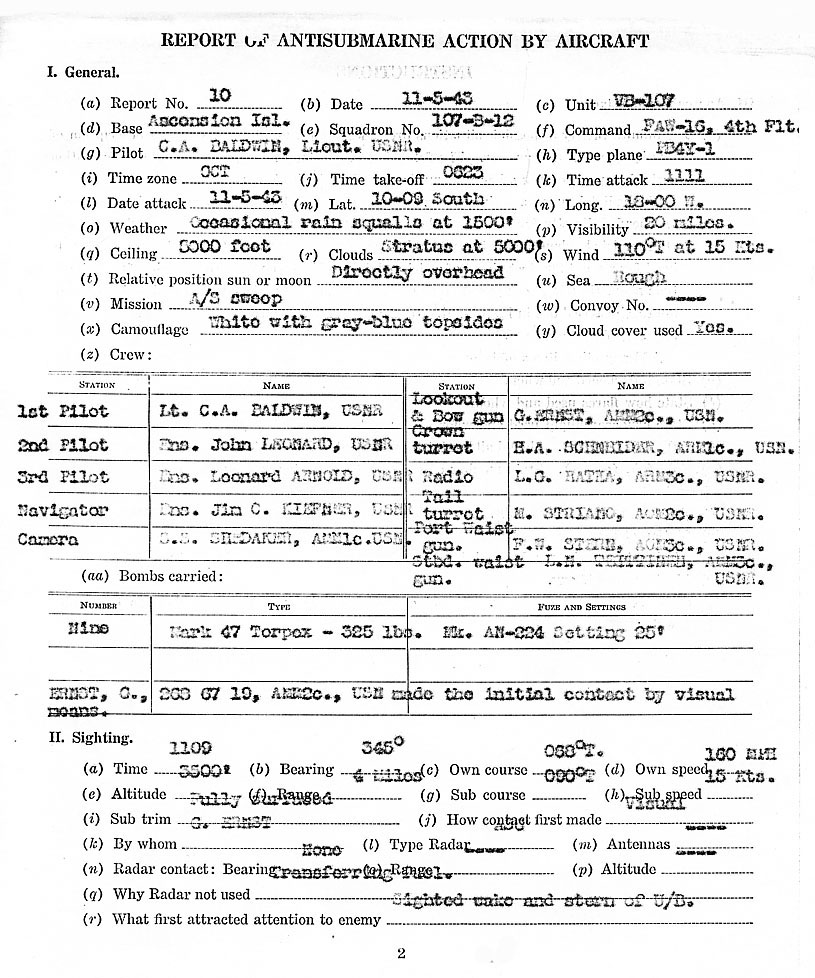
VB-107 ASW-6 #10

PILOTS NARRATIVE |
||
| Took off on patrol from Ascension Island at 0623. After being out five hours and having turned to the homeward leg, I decided to transfer fuel from the outboard wing tanks. This requires that the radio and radar be turned off. | ||
| At 1110 while transferring fuel and passing through a small front with base at 1000 feet, I was flying at 3500 feet on course 0680 T, position 10-09 S and 18-00 W, when the bow watch reported the sighting of a ship through a break in the clouds, at which time the co-pilot and myself sighted the same object at about five miles, two points off the port bow. I said, "Heck", that's a Nazi Submarine", which sent everyone to battle stations. Radio was turned on and by that time we were just coming into the clear, still at 3000 feet. I sighted the sub again on my port beam, distance one and a half miles. The sub was on course 0900 T, speed 15 kts or better. | ||
| Making a diving turn to port and coming across the sub on his port beam, air speed 250 MPH, altitude 75 feet, I dropped six bombs, one just forward of conning tower. Pulled up and into a steep port bank and began second run. This time the sub was turning about to his starboard and I was unable to straighten the plane out in time and passed the sub about sixty feet inside of his turn. Turned again to my port for a third run. At a target angle of about 60 degrees, altitude 25 feet, I dropped the three remaining bombs which were seen to explode short. Then pulling out to port and away, I looked back and saw sub still in his turn and losing a great amount of oil. I was also able to see three puffs of smoke which I believe were the only shots fired at me during my three runs. There was enough personnel top side of sub to man all guns but the reason for the light fire was the excellent shooting of my gunners and the element of surprise. | ||
| After pulling out I was able to contact 107-B-4 by voice and tell him of the attack and started sending MO's so as to home him in on the target. In the mean time the sub was still losing oil and appeared to be down by the stern steering an eratic course in a southerly direction making about 4 or 5 knots. | ||
At 1245 B-4 arrived and I made a strafing run on his first drop coming at the sub from its port side. B-4's bombs were seen to drop short. |
||
After B-4's attack the U-boat continued on an erratic course progressing in a southerly direction and returned to the position where I originally attacked him at 1330. At this time the U/B was able to cruise on a straight course and headed west. |
||
107-B-8 homing in on me arrived at 1340 Z and made an attack from the U/B's stern. At about 1000 yards from the U/B smoke started coming from his #2 engine. At the time I made a coordinated strafing run in on the sub's starboard beam breaking off at 400 yards and |
||
PILOTS NARRATIVE (CONT'D) |
||
| turning to port. B-8's bombs fell short. Baker 8 then returned to base due to engine trouble. | ||
| At 1515 the U-boat stopped losing oil and thereafter cruised at 10 to 12 knots for short periods of time. | ||
| Captain Main of Army First Composite Squadron piloting a B-25 arrived at 1545 and made two bombing runs from 1400 feet. Bombs fell short. | ||
| Major Atkins of same unit also in a B-25 arrived at 1635. I then left at 1635 and headed for base. At 1642 I met 107-B-4 (Lt. S.K. Taylor) and directed him to the target. | ||
At 1700 met Major Orr of the First Composite Squadron in a PBY-5A (US-2) and directed him to target. Landed at Ascension at 1833. |
||
The following planes homed on B-12: |
||
107-B-4 - Lt. Ford. |
||
| 107-B-8 - Lt. Hill. | ||
| Captain Main - B-25 (540) U.S. Army. | ||
| Major Akins B-25 (629) - U.S. Army. | ||
| Lieut. Carpenter - B-25 (1339) U.S. Army. | ||
| Major Orr PBY-5A (US 2) US Army. | ||
| 107-B-4 - Lt. S.K. TAYLOR. | ||
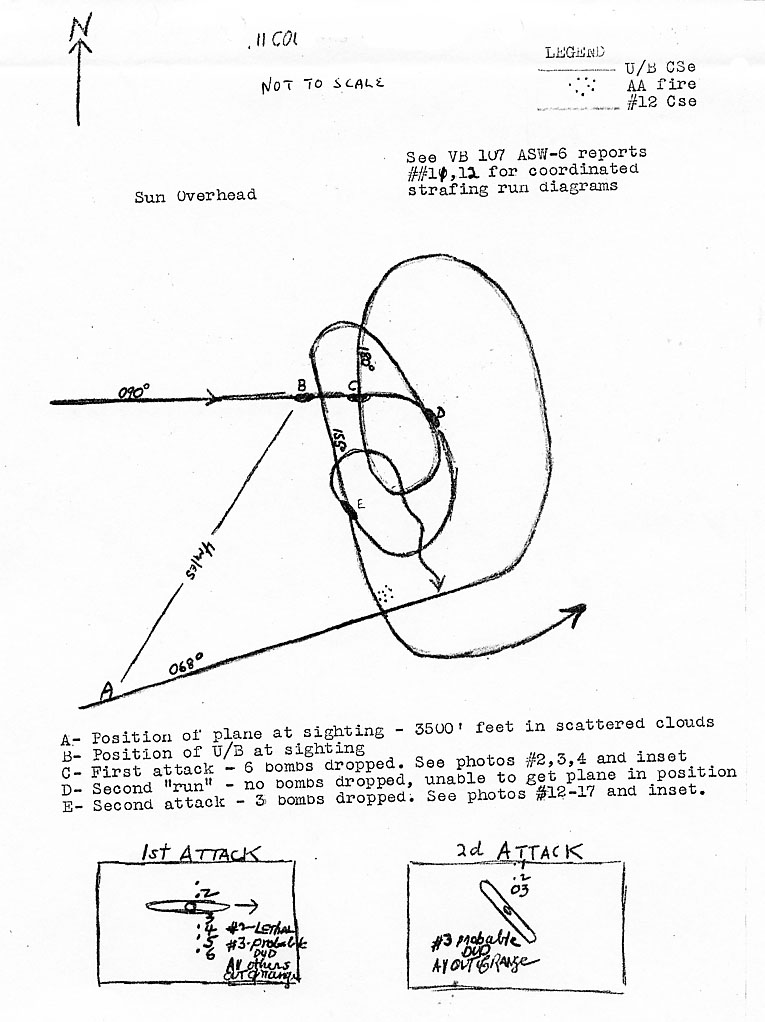
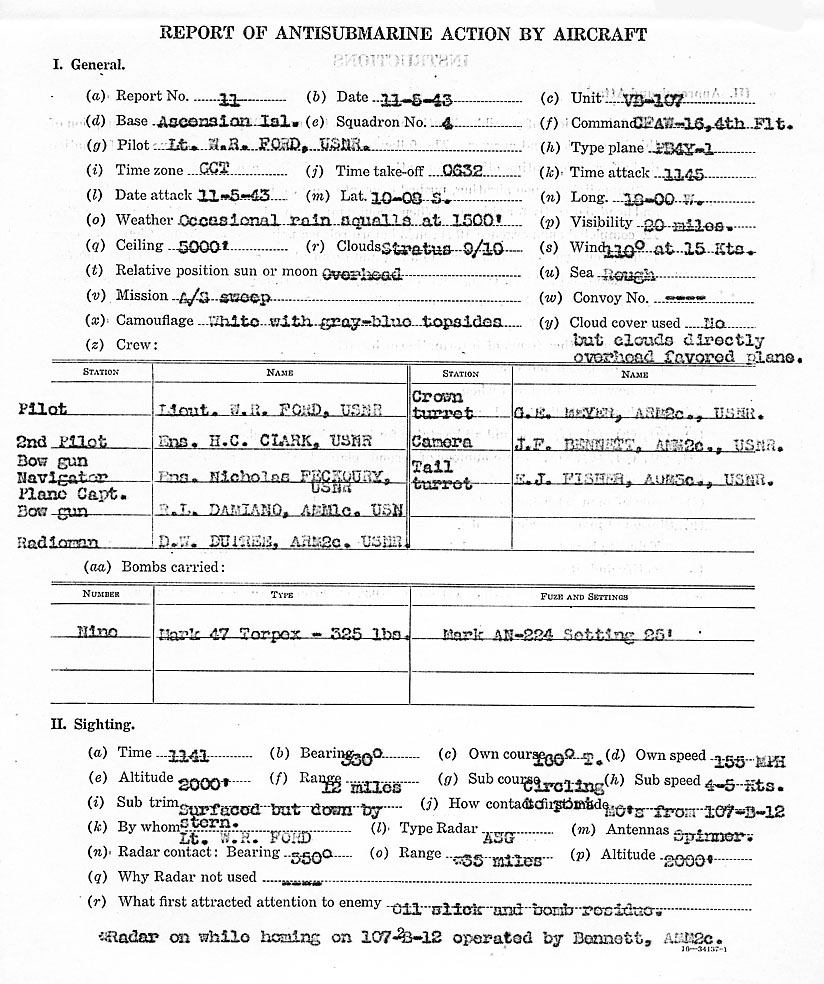
PILOTS NARRATIVE |
||
| While returning to Ascension Island on the return leg of a 600 mile sub sweep with 107-B-12 the morning of November 5th, we intercepted the sub contact report sent by 107-B-12 at 1110. Within two minutes B-12 called on voice stating that he had attacked a large sub at Posit 0953 S, 18-08 W, making three runs, and damaging the sub so that it was unable to submerge. We altered course to 1800 mg., position of sub being twelve miles away. B-12 was setting up to send MO's on 414 Kc when he called us, then homing to position in a few minutes; we at first saw nothing then our radar picked up target at 35 miles, 3500 relative bearing. Following MO's and target, soon saw sub at 10-08 S 18-00 West. Sub was in a large circling left turn on sighting. At this time secured radar and manned battle stations. When 1 to 1 1/2 miles away the sub opened up with heavy anti-aircraft fire. This was mostly to our port and below, so believing that they would soon correct and score hits on us, we turned to port and lost altitude until we were within the smoke puffs of the AA fire. Their subsequent fire was taken on our starboard bow and beam in or former position. As we straightened out for our diving run, our crown turret and then both bow guns opened up with very accurate fire on the conning tower scoring either very good hits on personnel or scaring the hell out of the subs gun crews (see photos) which resulted in stopping all AA fire. Released six Mk 47 D/B set for 25' spaced 60 feet at 200 Kts at approximately 150 feet altitude. Target angle 1000, our speed 220 MPH. Crossed over C/T at about 25 to 30 feet altitude. The tail turret opened with very accurate fire, being unable to hold on C/T due to sharp pullout. | ||
| When we gained 500 ft. altitude and started turn B-12 advised that we had dropped short! (that hurt). Completed sharp left turn and made second run with our guns firing very accurately (encountering no opposing fire). THis time we dropped 3 Mk 47 (same settings) our altitude at drop being 100 feet (nose down) air speed 250 MPH. Crossed over C/T on 240 target angle, altitude 25 ft. This drop looked fair but estimate 30 feet short on closest bomb. Turned to port in climb and sent base a message requesting that standby plane be sent to this position immediately. As B-12 was set up on 414 Kc and ready to home relief planes and having more fuel we set course for base at 1155. We landed at 1335, regassed, rearmed and the plane under command of Lt. S.K. Taylor took off again at 1513. The team work, gunnery, photography, navigation and communications on the part of all the crew members was perfection. | ||
VI. Signatures and Comment.
I have examined the above report. It is correct to the best of my knowledge and belief.
COMMENT OF SQUADRON OR UNIT COMMANDER:
U.S. GOVERNMENT PRINTING OFFICE 485531 |
||||||||||||||||||
VB-107 ASW-6 #12
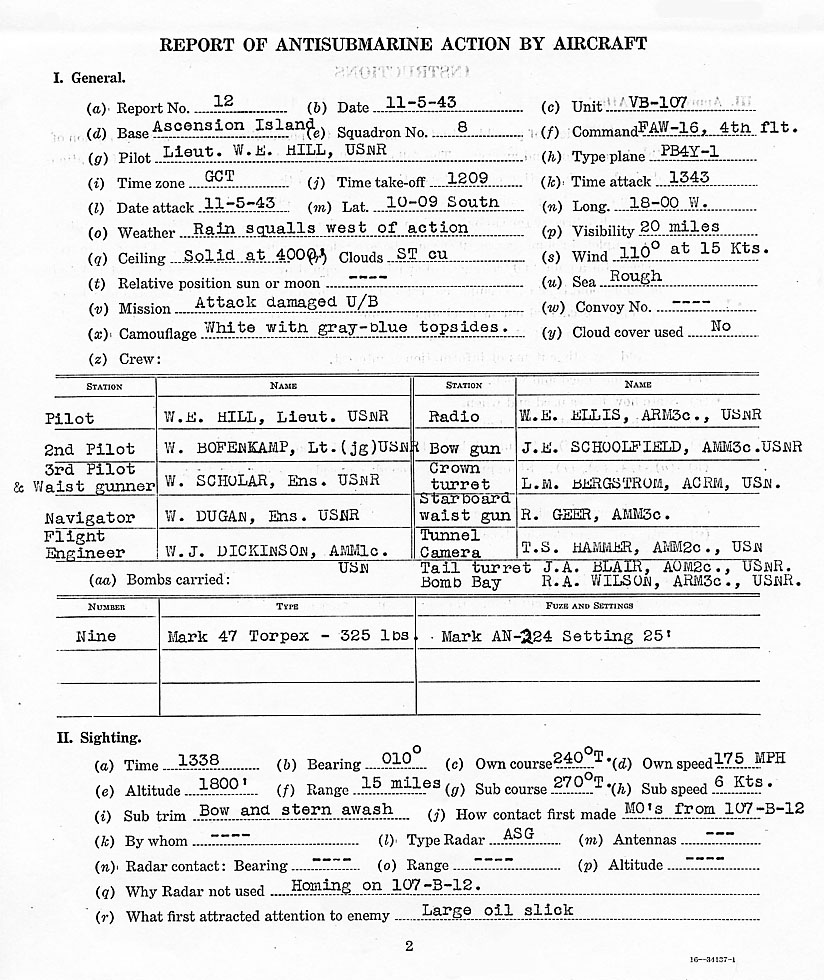
Narrative of 107-B-8 attack on 5 NOVEMBER 1943 |
||
| Took off from advance base at 1209 to assist 107-B12 and 107-B-4 against enemy submarine in position 10-09 South, 18-00 West that had been attacked and damaged by No. 12 at 1111 and by No. 4 at 1145. | ||
| Enroute to sub position, test fired lower bow gun, both waist guns and tail guns, but did not test the crown turret, because it was believed that its firing might damage the direction finder. At 1230 contacted #4 on voice frequency, and he gave me information concerning the tactics of the sub and the amount of anti-aircraft fire that I might encounter. At 1245 picked up the MO's #12 was sending and homed in on them. | ||
| My E. T. A. at the position was 1342 and at 1335 I noticed a rather large swing of the radio compass, indicating my nearness to #12. Shortly thereafter I saw the oil slick that was left by the Sub. Contacted #12 and suggested a combined attack, provided he had sufficient ammunition to do so. At the western side of the slick, I spotted the conning tower deck of the sub from a distance of approximately ten miles. | ||
| Sub course was 2700 true, speed 4-6 knots, stern low. Plane course at sighting was 2400 true, indicated airspeed 175 MPH, altitude 1800 feet. We increased power to 2400 RPM, 38" manifold pressure and sounded general quarters - all stations reported ready. Started a power glide and leveled off at 1400' until I was about five miles from the sub, when I then applied full throttle and started my run, indicating about 200 MPH. Target angle was 160 degrees at the time I started my run, but the sub turned to starboard, making the final target angle 90 degrees. At about two miles from the sub, I noticed three puffs of white smoke from explosive shells that were above and to the left. When between a mile and a half a mile from the U-boat, I heard something hit the plane and believed it to be in the fuselage. The bow gunner was strafing the sub's deck where the enemy gunners were, but the crown turret failed to fire due to an error in assembling the gun bolts. | ||
We crossed over the sub just aft the conning tower, indicated airspeed 208 MPH, altitude about 100' to the sub. During my approach #12 started a strafing run from ahead of the sub. As I passed over the sub, both waist guns fired as they were able to bear on the sub, and the tail turret fired after we passed over. |
||
On the pull-out, I started a climbing turn to the left. The port waist gunner called on the interphone and informed me that number 2 engine was on fire. We feathered the prop, cut the engine and the fire went out in a very few seconds. |
||
After the prop was feathered, I started to climb, turning to the right, and was able to climb to 4000' where I leveled off. I remained in the area until 1410 at which time I set course for the base, landing O.K. at 1612. While in the area |
||
in again and drop the remaining four depth charges but decided to return to base. My reasons for this were: Army planes were approaching the scene with bombs; #4 was being reloaded; the sub was damaged and could not submerge; the base was only about 260 miles away; and that it would be safest for all in the plane. |
||
| On the approach, the co-pilot could see flashes of gunfire from several places on the gun platform aft the conning tower, also some tracers going by the plane. Plane #12 informed me after the attack that my plane was surrounded by puffs from explosive shells, but most were behind. No other damage was done to the plane except for a disabled engine. No injuries to the crew. | ||
| W.E. HILL | ||
VB-107 ASW-6 #13
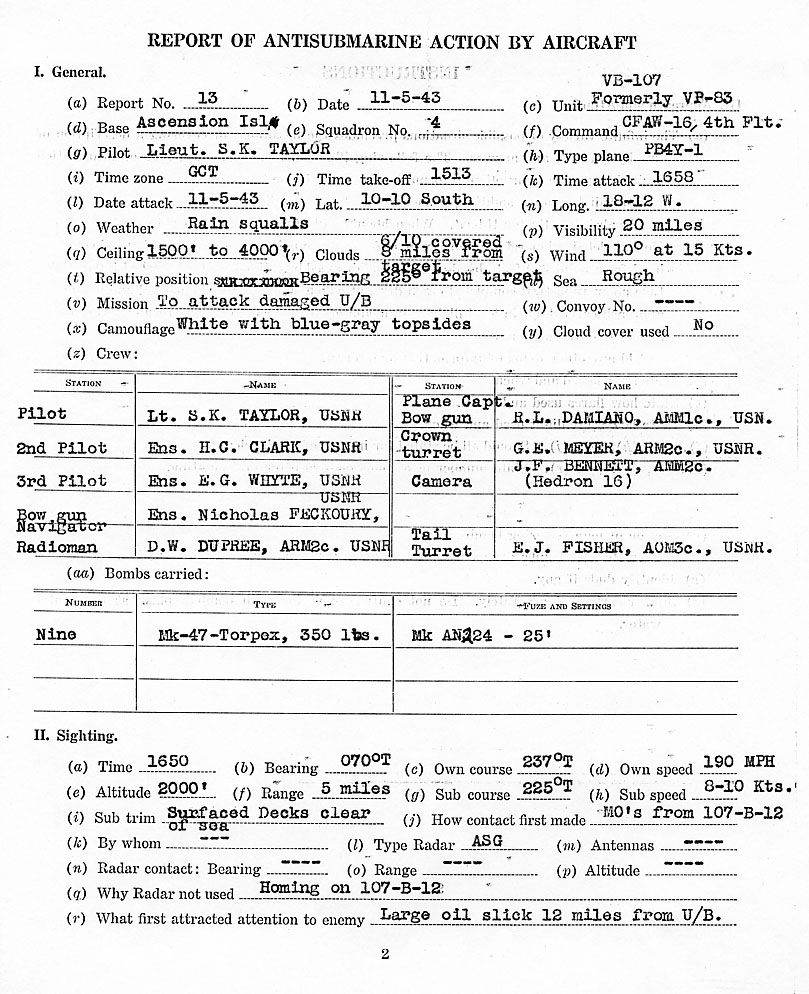
PILOTS NARRATIVE |
||
| At 1513 (GMT), Friday, November 5, 1943, took off from Ascension Island to destroy if possible an injured, and then three times attacked submarine. | ||
| With the exception of the third pilot (Ensign Whyte), and myself the crew had just returned from a previous engagement with the same sub to gas and get a new supply of bombs. | ||
| We flew out at 2000 feet, more or less, just under the ceiling or strato cumulous clouds, the sky being nine tenths covered. The course out to the position (10-08 South, 18-00 West) was 2600 magnetic. E.T.A. was given by navigator as 1649. | ||
| On the way out, we were in contact with 107-B-8 who had attacked the sub and was returning to base because its #2 engine had been shot out of commission. | ||
Around 1625 we picked up MO's from 107-B-12 who made first attack and was still circling in area. |
||
Over the earphones came reports from the two B-25's that had made horizontal drops with 500 lb. demolition bombs. They reported as coming close but not quite close enough. |
||
At 1650 we sighted the submarine approximately eight miles ahead and twelve miles West of oil slick. He was on a course approximately 2450 magnetic. We made sighting known to the B-25 circling overhead and to Ascension Controller. We estimated the speed of the sub to be between 8 and 10 knots. |
||
| Prior to sighting all guns had been test fired and bombing system checked. | ||
| We turned to right of sub and began a wide counter clockwise circle hoping to attack from the bow. Our altitude was 2200 feet and ceiling had lifted to 2800 or 3000 ft. Sky 6/10 covered. | ||
| The sub continued on course until we got even with his bow about five miles away. Then he began turning to starboard, bring his bow toward us. | ||
| We then began to turn left and to close in maintaining about 2000 feet altitude. | ||
| He continued his starboard turn as if attempting to present a beam target. We then applied high RPM and 44 in. manifold pressure and began our dive turning sharply to left again (later gun fire was reported to have passed over our #3 engine and cannon fire | ||
PILOTS NARRATIVE(CONT'D) |
||
| behind us while we were in this turn). We straightened out of turn and made attack over bow on course 086 Mag. with about 3150 or 3200 target angle, dropping five 350 lb. flat nosed torpex depth bombs spaced at sixty feet at 220 MPH. The drops was made from 70 feet at 265 MPH indicated. | ||
| From one-half mile out there was continuous firing from the two bow guns and the crown turret of plane. The Co-pilot said later that the firing was concentrated over the conning tower. As we passed over the tail turret went into action. (Report came from the tail gunner and the B-25 overhead that the drop looked good). | ||
| We immediately followed up the first drop by pulling up to 400 feet and 160 MPH and whipped around making a run over the sub's starboard bow, the four remaining depth bombs falling along the sub's starboard side. The speed of plane this time was 190 MPH at 50 feet altitude, with same power setting as before. In this attack the sub appeared to be still turning to starboard and listing to starboard, but making no headway. | ||
| After pulling out of dive and around in position to see the submarine, it appeared to be settling straight down, until suddenly from the conning tower forward, it shot up in the air, and then there was a terrific cone shaped explosion, coming from and surrounding the entire sub, which rose high in the air. As this subsided everything seemed to be swallowed by the sea. | ||
The next instant there appeared in the middle of the oil patch a group of men, 25 or 30 in number, three life rafts, and a dark object which looked like part of the broken submarine. The apparent part of the sub soon disappeared below the surface. We then estimated there to be between fifteen and twenty men, part of them in the rafts, part hanging on and others swimming or floating. One of the rafts failed to open and sank. |
||
We dropped one life raft. Men were seen to get in it. |
||
An Army PBY arrived soon after the attack. Three life rafts were dropped from it. The PBY stood by and sent MO's on 500 Kc while we departed in search of the H.M.S. Fort Cumberland. |
||
| We attacked and sank the sub at 1700 position 1010 south, 1812 west and found the Fort Cumberland with the aid of radar at 1800 bearing 299 T and 35 miles from survivors. | ||
| We told ship by blinker of survivors, giving position, bearing and distance from ship and requested that ship pick them up. The ship received the message, but did not say whether or not it would comply. | ||
| At 1900 we left the ship and homed on the MO's of the PBY back to the survivors. It was getting dark and we decided that there was | ||
PILOTS NARRATIVE(CONT'D) |
||
| nothing more that we could do out there. So the PBY and we departed at 1915 for Ascension. We landed, as predicted by the navigator, at 2135. | ||
| The wind was estimated at 15 Kts. from 120 true during and after the attack. | ||
| The gunners on the plane did excellent shooting, the photographers got good pictures with a K 20 camera from the tunnel hatch, but ran out of film after the last run over the sub, therefore failing to get pictures of the survivors and of the submarine exploding. The 2nd and 3rd pilot did a good job pushing throttles and watching the instruments. | ||
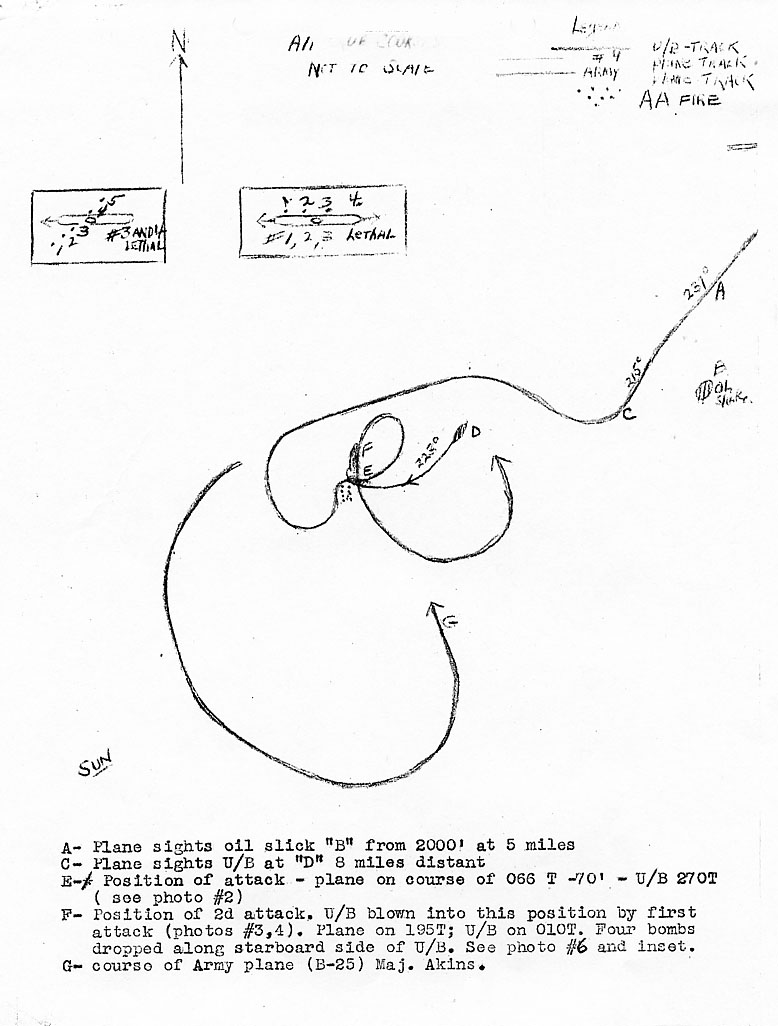
VI. Signatures and Comment.
I have examined the above report. It is correct to the best of my knowledge and belief.
COMMENT OF SQUADRON OR UNIT COMMANDER:
U.S. GOVERNMENT PRINTING OFFICE 485531 |
||||||||||||||||
UNITED STATES ATLANTIC FLEET |
||||||||||||||||||||||||||||||||||||||||||||||||||||||||||||||||||||||||||||||||||||||||||||||||||||||||||||||||||||||||||||||||
BOMBING SQUADRON ONE HUNDRED SEVEN |
||||||||||||||||||||||||||||||||||||||||||||||||||||||||||||||||||||||||||||||||||||||||||||||||||||||||||||||||||||||||||||||||
LOG OF EVENTS OF NOVEMBER 5, 1943. |
||||||||||||||||||||||||||||||||||||||||||||||||||||||||||||||||||||||||||||||||||||||||||||||||||||||||||||||||||||||||||||||||
|
||||||||||||||||||||||||||||||||||||||||||||||||||||||||||||||||||||||||||||||||||||||||||||||||||||||||||||||||||||||||||||||||
UNITED STATES ATLANTIC FLEET |
||||||||||||||||||||||||||||||||||||||||||||||||||||||||||||||||||||||||||||||||||||||||||||
BOMBING SQUADRON ONE HUNDRED SEVEN |
||||||||||||||||||||||||||||||||||||||||||||||||||||||||||||||||||||||||||||||||||||||||||||
LOG OF EVENTS OF NOVEMBER 5, 1943 (CONT'D) |
||||||||||||||||||||||||||||||||||||||||||||||||||||||||||||||||||||||||||||||||||||||||||||
|
||||||||||||||||||||||||||||||||||||||||||||||||||||||||||||||||||||||||||||||||||||||||||||
GENERAL COMMENTS OF COMMANDING OFFICER |
||
| Beginning with the sighting by 107-B-12 at 110 Zebra on November 5, an intensive ASW action was conducted at 10-09 S 18-00 W for 5 1/2 hours, with a live and always active 1200 or 750 ton German U-boat for a target. During this period seven attacks were made by Liberators which dropped a total of 33 Mark 47 depth bombs. In addition two medium altitude attacks were made by Army B-25 planes dropping ten demolition bombs. In all seven of the Liberator attacks the enemy was engaged with heavy fire from the planes. During the third, fourth and fifth attacks 107-B-12 made strafing runs coordinated with the bombing runs to distract the fire and further damage the submarine. So much was learned by the reporting unit that this action is considered a very good school in ASW. | ||
| The submarine was a "dirty black" color. From photographic interpretation the length is estimated to be 285 to 300 feet. The hatches in the stern and forecastle indicate a possible cargo carrier or mine layer - the beam is not great however. The bow had a decided rake and the speed when sighted appeared in excess of 15 knots. The armament consisted of one 4.1" deck gun on the forecastle which was not manned, four 337 or 40 MM cannon in twin mounts on the conning tower and a quadruple mount of 20 MM guns on a step about the C.T. The anti-aircraft gun platforms were enclosed with metal railings which gave a basket effect. The guns were protected by light spray shield armor. Photographs which 107-B-12 obtained on its second run show the turning circle for a 900 turn with the stern low and the rudder hard over. The stern low condition probably shortened the turning circle somewhat. 107-B-12 also timed a similar turn and found a 900 turn required 22 seconds. | ||
| There can be no doubt that the submarine was capable of firing at the attacking planes on all except the first and probably the last Liberator attacks. When he was allowed to fire, his bursts were quite accurate. The ineffectiveness of his fire in six of the seven attacks was due to the following: (1) accurate counter-fire from the attacking planes, (2) The choice of an attack position on the bow of the submarine. This maneuver gives the plane several advantages. It blankets the fire of the after guns and affords the bombardier his easiest target in range unless the U-boat turns. If he does turn the subs gunners have a very difficult gun platform which consistently disperses their fire while the aircraft gunners have a no deflection shot. Furthermore there is no evasive tactic the submarine can employ that will carry him clear of the bomb stick if it is accurately placed, (3) Deliberate evasive action by the airplane. The "chasing salvo" technique employed by Lieutenant Ford in the third attack was notably successful. It is remarkable that when one or more of these factors obtained enemy fire was ineffective whereas in the one instance where none of the three obtained the plane was damaged. | ||
| An enlargement of photographs Nos. 13, 14, 15 and 16 attached to report No. 11 herewith has proved of great morale value to our | ||
GENERAL COMMENTS OF COMMANDING OFFICER(CONT'D) |
||
crews. It illustrates the reaction of "Aryan Supermen" to well aimed counter fire. Some of them didn't duck soon enough and were seen to fall over the side "killed in action." |
||
| It has long been the intention of this command to employ medium altitude bombing with demolition bombs to clear the decks of a submarine forced to remain on the surface as this one was. The poor results obtained by the B-25's whose bombadiers are considerably better trained than the average ASW pilot or bombardier, were disappointing. It is now believed that a more effective tactic is the use of two or more planes in a coordinated low altitude attack. | ||
| After the initial contact report all communications were by voice transmissions on the AACS Ascension Island controller circuit. This system afforded the Senior Aviator and air controller a blow-by-blow description of the entire action and made possible the continuous relief of aircraft on station as needed. | ||
| Complete information concerning malfunctions and damage is not known here at this time. The planes were operating from an advanced base 1250 miles away. An investigation was conducted to determine who was responsible for the improper assembly of the guns in 107-B-8 but without result. The results of the investigation and tests of the arming devices on 107-B-12 are not known. The crown turret interrupter in 107-B-12 failed to function completely and one round of 50 caliber ammunition was fired through the port vertical stabilizer. The only resulting damage was a puncture of the skin which was readily patched. The shell which incapacitated the No. 2 engine of 107-B-8 hit a pushrod and exploded puncturing several oil lines, an ignition harness and three or four cylinders. The fire which resulted was an oil fire. | ||
| The erratic fall of bombs as caught by the camera is not understood. One such bomb in photograph No. 2 of report No. 10 herewith is obviously a ricochet but that is also unusual. | ||
Note that remarks have also been included on the backs of the photographs which represent local interpretations. |
||
Such details as this report contains were made possible by the intelligent and detailed questioning of the ACI officer attached to this squadron now serving with the Ascension detachment. |
||
RENFRO TURNER, jr. |
||
| Lieut. Comdr. USN. | ||